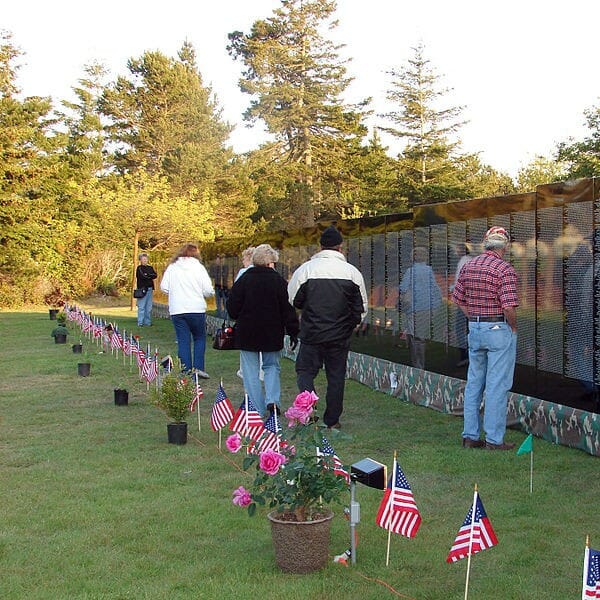Moving Walls

Where matters. Specifically, where a monument is built matters a great deal. These constructions are grown on particular sites, out of particular plans and origins, with a particular intent that can be subverted, or reinforced, over time. The context of the monuments should break over visitors’ heads–forcing each person to consider who visits, what surrounds, what grows in the monument’s wake.
In the case of Maya Lin’s memorial to Vietnam veterans, the context was particularly compelling. A somber black gash in the earth is surrounded by the District of Columbia’s white marble monuments to American greatness, in a prevailing architectural style that would make Mussolini feel welcome. Traveling to the Vietnam Veteran’s wall, visitors must first travel to the place where the late President Lyndon Baines Johnson invented the attack on the U.S. Navy at the Gulf of Tonkin. Veterans must come to Washington, to the headquarters of this memorialized war, to be in the place where the war was concocted and sustained. Their interaction with the official monument is particular; their actions are discrete. This memorial is the place where we list all of the war’s American dead, a single somber gathering point for an ugly piece of information. To touch a name on the wall is to touch the place where that name resides in the full company of its kind. It is that place, and, for better or worse, it is an experience that cannot be replicated.
But, of course, not too long after the actual wall was completed, several groups had to try and replicate the whole thing. These groups built replicas of the wall, hauled them onto trucks, and moved them across the country in an effort to bring an experience, one that is unique to a place, to the broader country.
Many of the traveling walls don’t pretend to be the real thing. They are made of plastic. They are only partially complete long black memorials. The traveling replicas, however, serve their visitors in several ways that the D.C. monument cannot. Most obviously, these replicas provide the means for those who can’t afford to visit Washington to participate in a moment in solemn contemplation in honor of this long and brutal war.
Less obviously, however, these literal moving monuments can also serve as therapeutic spaces for those Vietnam veterans who can’t bring themselves to look on, let alone touch the actual wall. Indeed, these moving walls are sometimes called The Wall That Heals.
This week a partial scale-model of the Vietnam Memorial Wall arrives, by trailer, to Santa Clarita, California, to be “erected in the Westfield Valencia Town Center parking lot, near the intersection of Magic Mountain Parkway and Citrus Street.” The plastic object will arrive in somber style, “escorted by California Highway Patrol officers, various veteran motorcade groups, the Fire Department and sheriff’s deputies escorting it on a truck down Magic Mountain Parkway.”
The American Veteran Traveling Tribute Vietnam Memorial Wall’s California sojourn is largely due to the efforts of Chuck Morris, a Korean War veteran and the commander of the Friendly Valley Veterans Club. Speaking to the Santa Clarita Valley Signal last June, Morris explains his motivation behind the project: “I wanted to bring this wall to Santa Clarita for the people who have relatives or know people whose names are on the wall and can’t afford to go to Washington.” Commendable to be sure.
In the landmark book The Texture of Memory: Holocaust Memorials and Meanings, author James Young considers how monuments and the act of remembering seek to “reinvigorate otherwise amnesiac stone settings with a record of their own lives in the public mind.” After all, Young writes, “neither memory nor intention is ever monolithic: each depends on the vast array of forces — material, aesthetic, spatial, ideological — converging in one memorial site.”
In this case, multiplication is subtraction. The metastasization of Vietnam memory is the precisely the product of forgetting, as the war grows old enough to commemorate in the parking lot of the mall (and, next week, in the parking lot of another mall). The great memoirs and films and stories of the Vietnam War began to emerge after the event had ended; public memory had to wait through the stunned silence that followed the conflict.
We’re certainly past the stunned silence, and now can travel to the shifting sites where, divorced from a broader context, people can mourn without having to commute too far. The convenience maybe laudable, even therapeutic, but does the traveling memorial undercut the experience of memorial remembrance. Or, is it more nuanced than this? Instead of undercutting the experience, do these traveling walls subvert the idea of static memorial, the idea of a shared national experience? With each few thousand dollar rental is the faraway official memorial somehow imbued with the experience of each local community?
For my part, I think the existence of a traveling replica necessarily implies the delivery of the replicated thing without the effort of travel.